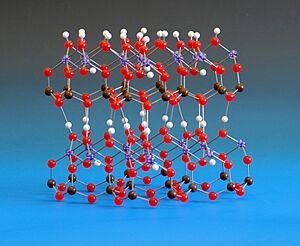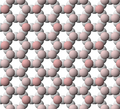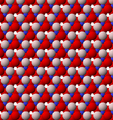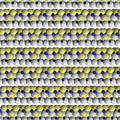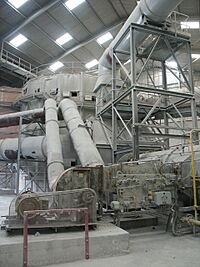Kaolinite facts for kids
Quick facts for kids Kaolinite |
|
|---|---|
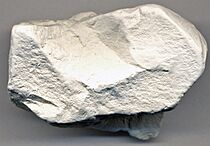 |
|
| General | |
| Category | Phyllosilicates Kaolinite-serpentine group |
| Formula (repeating unit) |
Al 2Si 2O 5(OH) 4, or in oxide notation: Al 2O 3 · 2SiO 2 · 2H2O |
| Strunz classification | 9.ED.05 |
| Crystal symmetry | P1 |
| Unit cell | a = 5.13 Å, b = 8.89 Å c = 7.25 Å; α = 90° β = 104.5°, γ = 89.8°; Z = 2 |
| Identification | |
| Color | White to cream, sometimes red, blue or brown tints from impurities and pale-yellow; also often stained various hues, tans and browns being common. |
| Crystal habit | Rarely as crystals, thin plates or stacked. More commonly as microscopic pseudohexagonal plates and clusters of plates, aggregated into compact, claylike masses. |
| Crystal system | Triclinic |
| Cleavage | Perfect on {001} |
| Tenacity | Flexible but inelastic |
| Mohs scale hardness | 2–2.5 |
| Luster | Pearly to dull earthy |
| Streak | White |
| Specific gravity | 2.16–2.68 |
| Optical properties | Biaxial (–) |
| Refractive index | nα = 1.553–1.565, nβ = 1.559–1.569, nγ = 1.569–1.570 |
| 2V angle | Measured: 24° to 50°, Calculated: 44° |
Kaolinite (pronounced KAY-uh-luh-nyte) is a common type of clay mineral. It's also known as kaolin or china clay. This mineral has a specific chemical makeup: Al2Si2O5(OH)4. It's a soft, earthy, and usually white mineral. Kaolinite forms when other minerals, like feldspar, break down due to natural processes like weathering.
Rocks that have a lot of kaolinite are called kaolin or china clay. Sometimes, kaolin can be pink, orange, or red because of tiny amounts of iron oxide. If there's less iron, it looks white, yellow, or light orange. You can even see layers of different colors in places like Providence Canyon State Park in Georgia, USA.
Kaolin is a very important material used in many industries around the world. It's sold as a powder, lumps, or a wet mixture. In 2021, about 45 million tonnes of kaolin were produced globally, showing how valuable it is.
Contents
What's in a Name?
The name kaolin came from the French language in 1727. It was taken from French reports about how Jingdezhen porcelain was made in China. The Chinese term, gāolǐngtǔ, means "High Ridge Earth." It came from a village called Gaoling ("High Ridge") in China, which was a main source of this clay for making porcelain. Later, the ending -ite was added to make "kaolinite," a common way to name minerals.
Sometimes, kaolinite was also called lithomarge. This old name comes from Latin words meaning "stone" and "marl." Today, "lithomarge" usually refers to a very dense, solid form of kaolin.
How Kaolinite is Made Up
Its Chemical Recipe
The chemical formula for kaolinite is usually written as Al2Si2O5(OH)4. This tells us it's made of aluminium, silicon, oxygen, and hydrogen (in the form of hydroxyl groups). In industries like ceramics, you might see it written as Al2O3·2SiO2·2H2O, which shows it as a combination of different oxides.
Inside the Structure
Kaolinite has a simple structure compared to other clay minerals. Think of it like a stack of thin layers. Each layer has two main parts:
- A tetrahedral sheet: This part is made of silicon and oxygen atoms. Each silicon atom is surrounded by four oxygen atoms, forming a shape like a small pyramid.
- An octahedral sheet: This part is made of aluminium, oxygen, and hydroxyl (OH) atoms. Each aluminium atom is surrounded by six oxygen or hydroxyl atoms, forming an eight-sided shape.
These two sheets are strongly connected within each layer. The layers themselves are held together by weaker bonds called hydrogen bonding.
Because of its structure, kaolinite layers don't have a strong electrical charge. This means it doesn't easily swap ions with other materials. Also, water molecules don't easily get between its layers. This is why kaolinite doesn't swell much when it gets wet, unlike some other clays.
When kaolinite clay gets wet, tiny water molecules stick to its flat, plate-like crystals. This makes the crystals stick together, giving the clay its soft, moldable feel. The bonds are weak enough for you to shape the clay, but strong enough for it to keep its shape. When the clay dries, the water leaves, and the crystals bond directly, making the clay hard but still a bit fragile. If you add water again, it becomes moldable once more!
How Heat Changes Kaolin
When kaolin is heated, it goes through several changes.
- Drying: Below 100°C, any liquid water in the clay slowly evaporates.
- Calcination: Above 400°C, the kaolinite crystal structure loses its hydroxyl (OH) parts as water. After this, the material can no longer be made moldable by adding water. This change is permanent.
- Further Heating: If heated even more, to very high temperatures (over 900°C and then 1050°C, and finally 1400°C), kaolin transforms into different, stronger materials. These changes are important for making things like ceramics and heat-resistant materials. For example, at 1400°C, it forms a strong, needle-like material called mullite, which is used in stoneware.
Where is Kaolin Found?
Kaolinite is one of the most common minerals on Earth. It's mined as kaolin in many countries, including Australia, Brazil, China, Czech Republic, France, Germany, India, United Kingdom, and the United States.
Large deposits of kaolinite are found in Western and Northern Europe. These deposits formed millions of years ago, from the Mesozoic to the early Cenozoic eras.
Kaolinite clay is very common in soils that have formed in hot, moist climates, like those in tropical rainforests. It forms when rocks break down chemically. In cooler or drier climates, you'll find less kaolinite and more of other clay minerals. Scientists use these differences in clay minerals to learn about past climates by studying ancient soils.
In the United States, major kaolin deposits are in central Georgia. This area is sometimes called the "white gold" belt because of the valuable kaolin found there. Sandersville is even known as the "Kaolin Capital of the World." These deposits formed between 100 and 45 million years ago from weathered rocks. In 2011, the United States produced 5.5 million tons of kaolin.
What is Kaolin Used For?
Kaolin is a very versatile mineral with many uses!
Main Uses
- Paper: A huge amount of kaolin is used to make paper. It helps make paper look brighter, feel smoother, and accept ink better. It can make up a large part of the paper's weight. It's also used as a filler to make paper more opaque.
- Ceramics: Kaolin is a key ingredient in making white ceramic items like plates, tiles, and sinks. It helps the clay become moldable before firing and strong after it's baked in a kiln. It's important for creating the strong, glassy parts of ceramics. The best kaolin for ceramics makes the final product very white.
Other Industrial Uses
- Insulation: It's used to make a type of insulation material called Kaowool.
- Paints: Added to some paints to make the white color brighter and to change how shiny the paint is.
- Rubber: Used to change the properties of rubber when it's made.
- Adhesives: Added to glues to change how they flow and stick.
- Water Treatment: Can be used to help clean water and wastewater by absorbing impurities.
- Concrete: A special form called metakaolin can be added to concrete to make it stronger and more durable.
- Geopolymers: Metakaolin is also a basic part of special materials called geopolymers.
Everyday and Medical Uses
- Stomach Upset: Historically, kaolin has been used to help soothe an upset stomach.
- Diarrhea Treatment: Some medicines for diarrhea contain kaolin.
- Skin Protection: It's an ingredient in some skin protection creams.
- Blood Clotting: Kaolin can help blood clot faster. The US military uses a special gauze with a kaolinite-derived material to help stop bleeding quickly.
- Toothpaste: Used as a mild abrasive to help clean teeth.
Beauty and More
- Cosmetics: A common filler in many cosmetic products.
- Facial Masks and Soaps: Used in beauty masks and soaps for skin care.
- Spa Treatments: Found in spa body treatments like body wraps.
Other Interesting Uses
- Dating Rocks: Scientists can use tiny traces of elements in kaolinite to help figure out the age of rocks.
- Historical Eating Practices: In some parts of the world, like Africa and historically in parts of the Southern United States, some people have eaten kaolin clay for various reasons. This practice is known as geophagy.
- Building Projects: In geotechnical engineering, kaolinite is studied for its role in soil and rock stability for construction.
- Light Bulbs: Used inside white light bulbs to spread light evenly.
- Farming: Sprayed on crops in organic farming to protect them from insects and sun damage.
- Traditional Homes: Used as a whitewash on stone homes in places like Nepal.
Where is Kaolin Produced?
Here's a look at how much kaolin was produced around the world in 2012:
| Global - total | 26,651 |
|---|---|
| Egypt | 275 |
| Nigeria | 100 |
| Algeria | 80 |
| Tanzania | 45 |
| Sudan | 35 |
| Uganda | 30 |
| South Africa | 15 |
| Ethiopia | 2 |
| Kenya | 1 |
| Africa - total | 583 |
| China | 3,950 |
| South Korea | 800 |
| Vietnam | 650 |
| Malaysia | 450 |
| Thailand | 180 |
| Indonesia' | 175 |
| India | 75 |
| Bangladesh | 20 |
| Taiwan | 17 |
| Pakistan | 15 |
| Sri Lanka | 11 |
| Japan | 3 |
| Philippines | 2 |
| Asia - total | 6,348 |
| Germany | 4,800 |
| UK | 1,000 |
| Czech Republic | 650 |
| Italy | 625 |
| France | 350 |
| Portugal | 325 |
| Spain | 300 |
| Bosnia–Herzegovina | 250 |
| Bulgaria | 225 |
| Russia | 170 |
| Poland | 125 |
| Ukraine | 100 |
| Serbia | 90 |
| Austria | 65 |
| Denmark | 3 |
| Europe - total | 9,078 |
| USA | 5,900 |
| Mexico | 120 |
| N. America - total | 6,020 |
| Iran | 1,500 |
| Turkey | 725 |
| Jordan | 100 |
| Saudi Arabia | 70 |
| Iraq | 3 |
| Middle East - total | 2,398 |
| Australia | 40 |
| New Zealand | 11 |
| Oceania - total | 51 |
| Brazil | 1,900 |
| Argentina | 80 |
| Paraguay | 66 |
| Chile | 60 |
| Colombia | 20 |
| Peru | 20 |
| Ecuador | 15 |
| Venezuela | 10 |
| Guatemala | 2 |
| S. & C. America - total | 2,173 |
Different Types of Kaolin
Here are some typical properties of different types of kaolin used in ceramics:
| Product name | SSP | Premium | Longyan 325# | Zettlitz 1A | OKA |
|---|---|---|---|---|---|
| Country | UK | New Zealand | China | Czech Republic | Germany |
| Manufacturer | Imerys | Imerys | Logyan | Sedlecky | AKW |
| % < 2 μm | 85 | 97 | 25 | 56 | 82 |
| % <1 μm | 50 | 88 | 15 | 41 | 50 |
| SiO2, % | 48.0 | 49.5 | 49.3 | 48.0 | 49.5 |
| Al2O3, % | 37.0 | 35.5 | 35.5 | 37.0 | 35.5 |
| Fe2O3, % | 0.44 | 0.29 | 0.22 | 0.68 | 0.43 |
| TiO2, % | 0.01 | 0.09 | 0.01 | 0.20 | 0.17 |
| CaO, % | 0.10 | - | 0.03 | 0.08 | 0.20 |
| MgO, % | 0.25 | - | 0.25 | 0.23 | 0.02 |
| K2O, % | 1.25 | - | 1.90 | 0.92 | 0.30 |
| Na2O, % | 0.15 | - | 0.09 | 0.07 | 0.01 |
| LOI% | 12.8 | 13.8 | 11.9 | 12.9 | 13.4 |
| Kaolinite, % | 95 | - | 40 | 89 | 86 |
| Halloysite, % | - | 92 | 40 | - | - |
| Mica, % | 4 | - | - | - | - |
| Quartz, % | 1 | 4 | 3 | 1 | 8 |
| Smectite, % | - | - | - | 1 | 6 |
| Cristobalite, % | - | 4 | - | - | - |
Is Kaolin Safe?
Kaolin is generally considered safe. However, it might cause a little irritation if it touches your skin or the inside of your nose or mouth.
Some kaolin products can have tiny amounts of crystalline silica. If you breathe in a lot of this silica dust over a long time, it can be harmful. That's why there are rules in workplaces to limit how much kaolin dust people can breathe in. For example, in the US, there are limits set by OSHA and NIOSH to keep workers safe.
See also
 In Spanish: Caolinita para niños
In Spanish: Caolinita para niños
- China stone
- Clay pit
- Dickite
- Halloysite
- Kaolin Deposits of Charentes Basin, France
- Kaolin spray
- Medicinal clay
- Nacrite
- Cornish China Clay Branches


